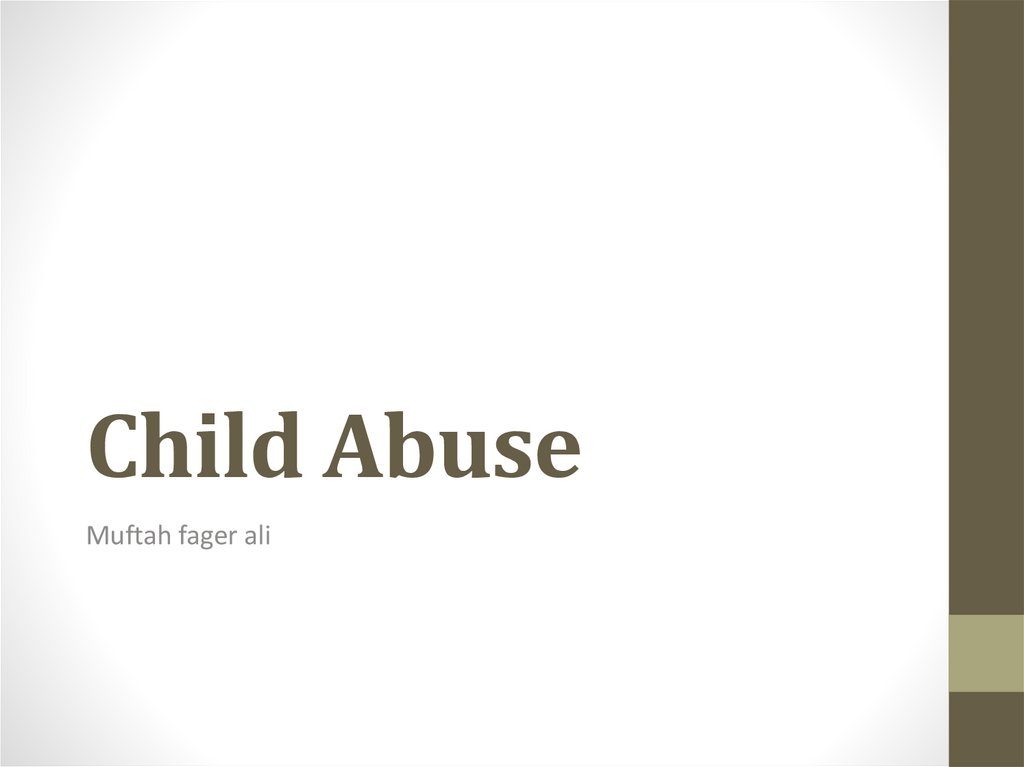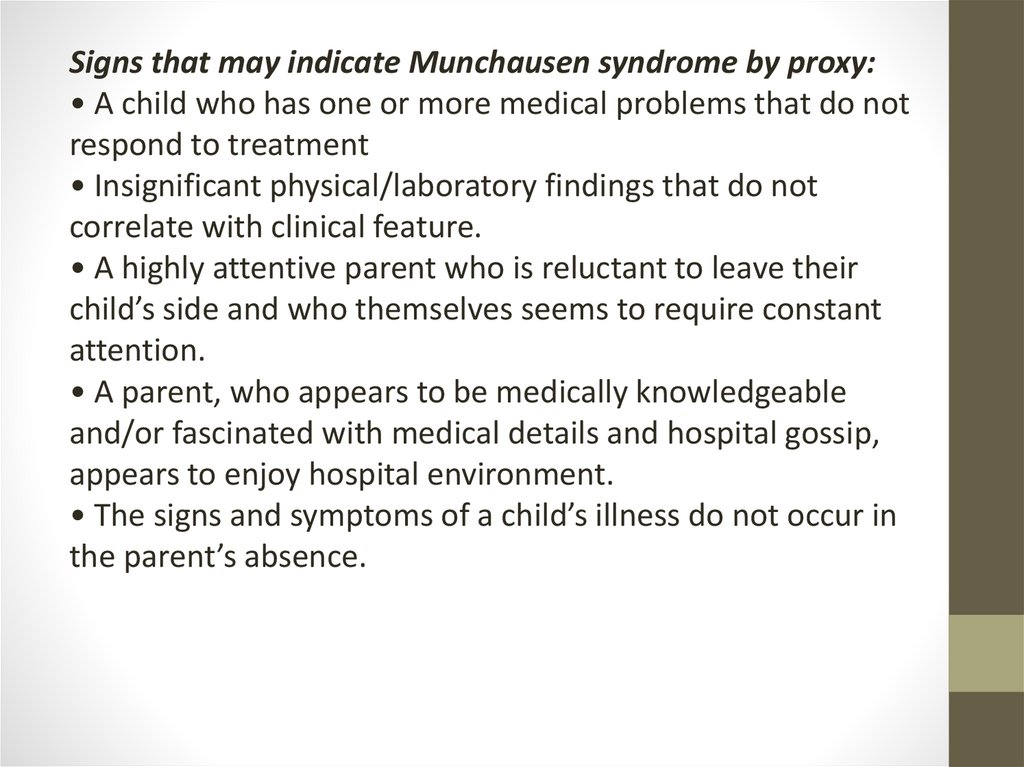Similar presentations:
Child Abuse
1.
Child AbuseMuftah fager ali
2.
Introduction3.
DefinitionChild abuse is a sick and ugly
emotional aspect of the family
dysfunction in the society
4.
Child abused5.
The four major types of child abuse are:• Physical abuse
• Sexual abuse
• Emotional abuse
• Neglect
6.
Physical child abuse result of:• Beating, slapping, or hitting
• Pushing, shaking, kicking, or throwing
• Pinching, biting, choking, or hair-pulling
• Burning with cigarettes, scalding water, or other
hot objects
• Severe physical punishment
7.
Sexual abuse of a child is identificationof possible child abuse always consider
child abuse in traumatic injuries to the
head and neck as 50% of the abused
children had head and neck injuries
8.
.Sexual child abusers can be:
• Fathers, mothers, siblings, or other relatives
• Childcare professionals or babysitters
• Clergy, teachers
• Foster parents or host families of foreign
exchange students
• Strangers.
9.
Emotional child abuse is any attitude, behavior, orfailure to act that interferes with a child’s mental health or
social development. It can range from a simple verbal insult
to an extreme form of punishment.
effects than either physical abuse or sexual abuse
Other names for emotional abuse are:
1) Verbal abuse
2) Mental abuse
3) psychological abuse.
10.
Types of Physical ChildAbuse
Shaken Baby Syndrome (SBS)
• Shaking a baby to try to stop
inconsolable crying.
Signs and symptoms.
Common symptoms are:
• Lethargy/decreased muscle tone
• Extreme irritability
• Decreased appetite,
.poor feeding or vomiting for no apparent
reason
11.
• Poor sucking or swallowing• Difficulty in breathing
• Seizures.
• Head or forehead appears larger
• Inability to life head
• Inability to eyes to focus
12.
Battered Child SyndromeA type of physical abuse reported by Henry Kempe in
1960 characterized by;
• Multiple asymmetrical fractures at different stages
of healing.
• Subdural hematoma
• Bruise marks shaped like hands, fingers or objects,
or unexplained bruises in areas where normal
childhood activities would not usually result in
bruising
13.
• Separated sutures• Evidence of unexplained abdominal injury
• At times even unexplained unconsciousness in infant.
• Evidence of fractures at the tip of long bones on spiral type
fractures that result from twisting
• Fractured ribs, especially in the back.
Investigations:
• Radiographs, MRI or CT-Scan
• Osteogenesis imperfecta
• Hemophilia
14.
• Von Willebrand’s disease. Munchausen Syndromeby Proxy
15.
Signs that may indicate Munchausen syndrome by proxy:• A child who has one or more medical problems that do not
respond to treatment
• Insignificant physical/laboratory findings that do not
correlate with clinical feature.
• A highly attentive parent who is reluctant to leave their
child’s side and who themselves seems to require constant
attention.
• A parent, who appears to be medically knowledgeable
and/or fascinated with medical details and hospital gossip,
appears to enjoy hospital environment.
• The signs and symptoms of a child’s illness do not occur in
the parent’s absence.
16.
Sudden Infant Death Syndrome (SIDS)It is any sudden and unexplained death of an apparently
healthy infant aged one-month to one year. The term
cot death is often used in United Kingdom, and crib
death in North America.
SIDS can be due to any reason but child abuse can be a
reason.
17.
Sexual AbuseIdentification of possible child abuse always consider child abuse in
traumatic injuries to the head and neck, 50% of the abused children had head and
neck injuries . This includes:
– Fondling
– Violations of bodily privacy
– Child pornography
– Exposing children to pornography
– Luring a child for sexual liaisons
– Sexual exploitation
– Exhibitionism
– Sexual intercourse with a child
– Trauma to mouth because of oral sex.
18.
Emotional AbuseEmotional child abuse is another person’s attitude, behavior to
failure to act that interferes with a child’s mental health or social
development. Emotional abuse has more long lasting negative
psychiatric effects than either physical or sexual abuse. Emotional
abuse can range from a simple verbal insult to an extreme form of
punishment
• Ignoring, withdrawal of attention, rejection
• Lack of physical affection
• Lack of positive re-inforcement
• Threats
• Habitual blaming
• Degradation, etc.
19.
NeglectTypes of Neglect
Physical neglect: Is not providing for a child’s physical needs, which are:
• Food
• Clothing appropriate for weather
• Supervision
• A home that is hygienic and safe.
Educational neglect: Failure to provide proper education rightful to the age of
the child.
Emotional/psychological neglect: Not providing emotional support and love
which is affection, attending to the child’s emotional needs, psychological care
as needed.
Medical neglect: Failing to provide needed basic medical attention to child’s
health care. It also includes “Dental neglect”:
1- Dental caries, periodontal diseases and other oral conditions.
2– Dental neglect.
20.
are four primary factors which contribute tochild abuse:
• Parent factors
• Sociocultural factors
• Environmental factors
• Child factors
21.
Bite MarksThis type of injury is usually associated with physical or sexual abuse.
In such suspected cases, a forensic pathologist or odontologist should
be contacted. Many times misdiagnosed as simple childhood bruises:
• Typically oval or circular configuration
• An area of hemorrhage, representing a “suck” or “thrust” mark,
may be found between tooth marks, suggesting physical or sexual
abuse
• Although marks may occur anywhere on a child’s body, the most
common sites are the cheeks, back, sides, arms, buttocks.





















 law
law








